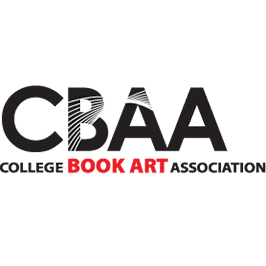.jpg)
“Set-up sheets are the sheets a printer uses to ‘set-up’ the press: to get inking, pressure, position, registration or other elements of the printing process coordinated. Many printers reuse these sheets several times, creating elaborate overprinting effects of random patterns which can be treated as ‘found art’ or poetry, cut up, bound, and made into a book. Dieter Roth used this approach in a number of works, and it is an idea which I have seen occur to many people who see the set-up sheets around a press.”
When I first read the above endnote in Johanna Drucker’s The Century of Artists’ Books, I saw myself—the idea to use the set-up sheets had occurred to me as well. I have also seen it occur to others. As Drucker notes, the idea is a cliché. A similar cliché is used by the novice printer who declares that they “like” the textured, too-light printing of wood type or a linoleum block, when in reality they didn’t take the time to add more packing or ink. I always teach my students to print “correctly,” at least to start, but I also have to admit that even in the context of an educational environment that “correctness” feels disingenuous to me. I too “like”—or really I am absolutely fascinated by—those too-light, too-heavy, or accidental marks that the press/matrix creates along the way. Mistakes have potential. The set-up sheets themselves might not make for a particularly interesting book, but the processes, marks, and collisions that they contain are something that can be used intentionally.
The idea that “bad printing” can be good/interesting is nothing new. The concept actually appears in a later endnote in that same chapter from Drucker’s book (endnote #14). The printer Amos P. Kennedy, Jr. has been advocating for “bad printing” for many years, and his work shows a mastery of the approach. Kennedy’s way of working is a major influence on my own—he improvises, he tests, he builds layers and layers of color, he paints and monoprints with brayers and ink knives, and he combines and recombines elements to play with repetition and difference. The primary lesson that I have learned from Kennedy’s work is that the consistency of the edition is not as important as the generative power of the multiple and the markmaking possibilities of the press. “Ink on paper,” as Kennedy often says.
“Good” printing has a result that we already know. What I love about “dirty” or “bad” printing is that it can always be elaborated and worked into. The variations of bad printing that I am working with now are “emergent” and “dislegible” printing.
If “legible” and “illegible” are binary opposites, then the term “dislegible” is about looking at the space between those two poles. Dislegibility displaces, dislocates, deforms, and/or disrupts the process of reading, with the ultimate goal of making that process of reading (dis)legible to the reader. The dislegible can be read, but it resists closure or certainty. The dislegible is the flicker or the blur, one thing becomes another, then another. The dislegible is (ideally) not a code to be broken or a puzzle to be solved, but a constant, recursive wandering in the process of reading. Dislegibility is an important tool in constructing emergent form.
The emergent is something that is always in the process of being made—a state of being that is constantly in transition, or on the edge of exceeding its imagined boundaries. The emergent work of art resists a static state (as perceived by the viewer) through complexity, movement, lack of finish, unpredictability, failure, disintegration, the generation of noise as part of the system, etc. A classic example of emergent form is “analytic” Cubist painting. At no point do those paintings congeal into an image of the still life or person. They require constant movement of the eye and active—but futile—assembly by the viewer. The impossibility of that assembly is what keeps the paintings engaging.
For me, bad/emergent printing is an approach that has the chance material beauty of facture in drawing and painting, but that also uses the iterative nature of printing and the multiple to produce objects not possible in drawing and painting. An approach that purposefully loses control—that embraces noise, chance, failure, and difference through repetition.
Work Cited
Johanna Drucker, The Century of Artists’ Books (New York: Granary Books, 2004) 15, 17.
Aaron Cohick is the Printer of The Press at Colorado College and the proprietor of the NewLights Press. He lives and works in Colorado Springs, CO.

